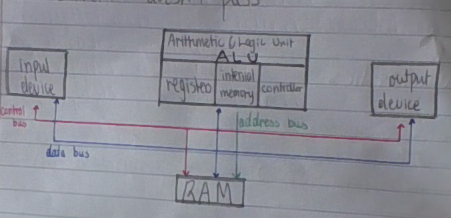Computer Systems
1/30
There's no tags or description
Looks like no tags are added yet.
Name | Mastery | Learn | Test | Matching | Spaced |
|---|
No study sessions yet.
31 Terms
specification
configuration of a computing system, such as:
hardware components
technical characteristics
secondary storage
a set of components that store programs and data
it still retains content when the power is off. e.g. hard disks or USB drives
all types except RAM and ROM
main memory
the component that stores programs/data currently in use.
these are volatile, meaning they are lost when the computer is off
this is known as RAM(random access memory)
RAM
random access memory—- accessed from any location in memory
ROM
read-only memory, non-volatile.
ideal for storing instructions and data that are needed for the computer to run.
processor
the component that executes program instructions
e.g. arithmetic operations, input/output of data, control program flow
CPU
central processing unit
how processors work
instructions are fetched one by one from memory, the processor executes each instruction, data is moved to memory/
a program’s execution
storage » memory » processor
yarns and needles on a shelf
resources temporarily moved to a coffee table
knitter looks at knitting pattern and does the knitting
communication components
how computer systems exchange and share information
input/output
how computing systems interact with the user and their surroundings.
input
data received, e.g. keyboard and mouse
output
data transmitted, e.g. printer, headphones
transistors
located inside processors, storing zeroes and ones.
early computers
no single memory for everything
no general purposes
programs weren’t stored in memory
slow and inflexible
Von Neumann architecture
a computer architecture where both instructions and data are stored in a single, shared memory space.
Von Neumann architecture characteristics
single processor
one memory for instructions & data
programs & data implemented one at a time
structure diagram

CPU circuit
integrated circuit that performs calculations
1= current passes through
0= current doesn’t pass
controller/ control unit
sends and receives signals from all parts of the computer, ensuring that all processes take place at the right time & in the correct order.
Bus
used to send control signals and data between processor and components
Control bus
manages communication between memory, input and output
data bus
exchange between all components
address bus
gets memory to ALU
ALU
Arithmetic and Logic Unit, processes and manipulates data.
performs simple calculations on data that’s temporarily stored in registers
Register
storage location found in CPU where data or control information is temporarily stored.
faster than internal memory since they are often accessed
internal memory
data is moved from registers to internal memory when not actively used.
(cache memory)
fast access, temporary storage on CPU.
main memory(in circuit)
describes computer memory used to store programs & data while being used by the CPU
only directly access data & programs if they’re in main memory
mainly RAM, ROM when computer is first turned on
cache memory
used between main RAM & CPU
improves performance by holding data that will be/has been processed
factors affecting CPU
processor speed = clock speed, measured in Hz
the faster that is, the faster a processor can run the fetch-decode-execute cycle.
1 tick per second = 1 Hz
c
core
used to describe the processing components within the CPU